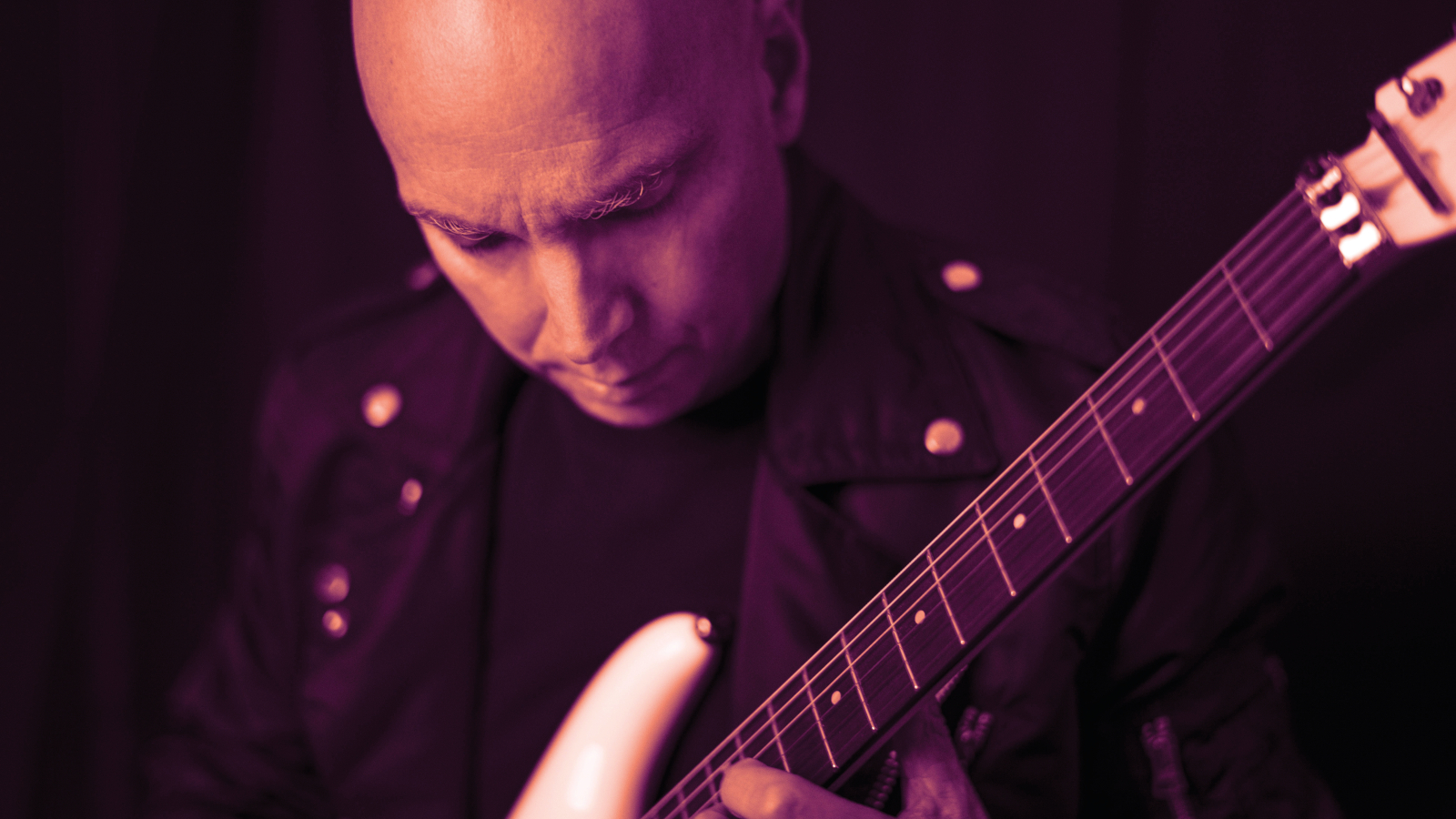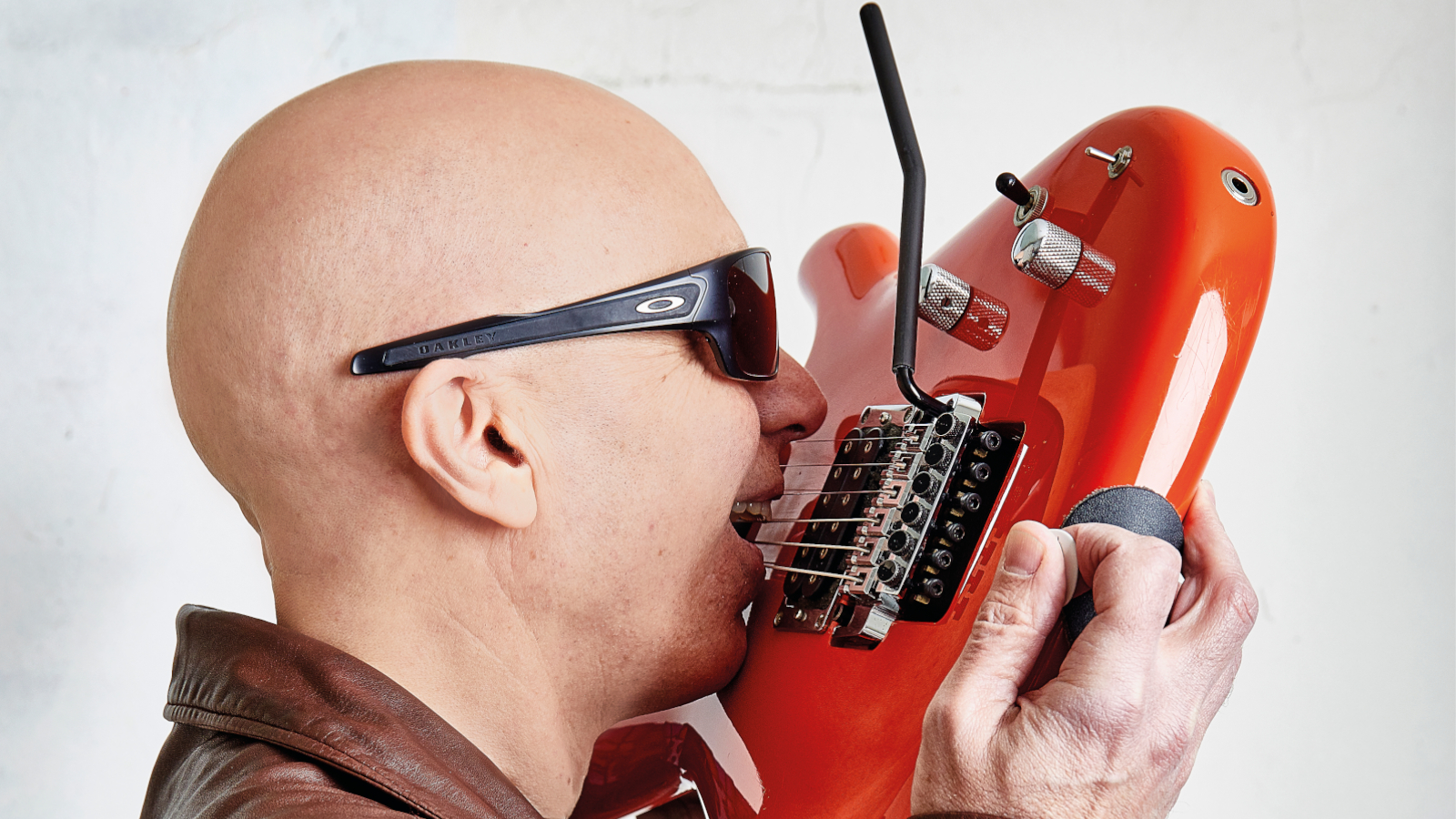
Years before he became one of the most celebrated guitarists on the planet, Joe Satriani was a club-gigging musician who paid his bills – sometimes barely – by teaching other aspiring players. His famous alumni includes the likes of Steve Vai, Kirk Hammett, Alex Skolnick and Primus’s Larry LaLonde, among others.
“It was a great experience,” Satriani says of his teaching days. “No matter what abilities my students came to me with, I always tried to give them their money’s worth and build their musical knowledge in ways they could grasp and use.
“And I tried to make the lessons fun, because I knew that if things got boring, they’d tune out and stop coming.”
In his own life, Satch considers himself ever the student.
I’m still teaching myself
Joe Satriani
“I’m still teaching myself,” he says. “I started out strumming the guitar and trying to grab bits of information from wherever I could, and in many ways that continues today. Some things you let slide along the way, and other things you obsess about.
“There are many rabbit holes you can go down, but to me there are certain aspects to guitar playing that you should always pay attention to.”
Here, Joe runs down his top ten tips…
1. TUNE UP FIRST
“It’s funny how this is such a neglected aspect of guitar playing. So much of the time, people grab their guitars because they’re inspired to play. There have even been records recorded that way. The guitarist doesn’t want his flow interrupted, and he winds up playing this amazing part with an out-of-tune guitar.
“Check your guitar’s intonation regularly so you know that, wherever you play on the fretboard, the intonation is accurate. Build a history of playing in tune, and it will become part of your signature sound.”

2. STRIKE YOUR STRINGS AT DIFFERENT PLACES IN THE PICKING AREA
“Years ago when watching footage of Hendrix, I noticed his picking hand didn’t stay in one place. Sometimes he’d pick at the bridge, while other times he’d move his hand toward the neck. It was a key element of his playing. Same with Keith Richards.
“I started trying it myself, and it unlocked this rich world of tone.
“Learn to move your picking hand around. This will allow you to shape the tone of each phrase and individual notes. Also, change your pick angle and the part of the pick you use. You’ll be surprised how much variation in tone you can get.”
3. PRACTICE ACHIEVING GOOD INTONATION WHILE BENDING NOTES
“Bending notes is cause and effect. You can determine what kind of effect you want, but you have to learn how to be in control to achieve a particular sound. It can be a scary guitar sound, or it can sound beautiful, but to achieve that result, you have to know how to get there.
“Fret a note on your B string and then drop down two frets and bend up to that note. Do this over and over again at a variety of fret positions using the first three strings.
“Bend half steps, whole steps and so on. Again, build a history of being in tune.”

4. PRACTICE SCALES OVER ACTUAL MUSIC
“It’s important to learn scale patterns, but if you spend all your time doing exercises, pretty soon everything you play will sound like scale patterns. Who wants to hear that?
“Playing over music is a good way to take what you’ve learned and apply scale tones to chords and chordal progressions.
“As an example, set up a two-chord pattern in one mode and jam over the top. Make sure to listen as you play. That’s what the audience does.”
5. VARY YOUR ROUTINE
“When I was learning how to play, I would get stuck on some exercise, and I would repeat it over and over. What I didn’t realize was how the repetition was working against me. It was making my playing stiff and nonmusical.
“Break out of that habit. Stay relaxed and change your guitar warm-up exercises each day. Crank up the variety factor.
“One day you can do the non-musical, finger-twisting stuff; the next, focus on arpeggios, and the next day it’s scales, and so on.”

6. DON'T DRAG YOUR PRACTICE SESSIONS OUT
“You can work on exercises and scale patterns forever, but after a while there’s a point where you need to stop and move on.
You’re not going to sell out theaters or get a billion streams online with finger exercises. Limit these routines. Keep them short and productive, but keep in mind they’re merely exercises, not actual music your audience wants to hear.
“Spend more of your precious practice time learning and playing music. It’ll be more enjoyable for you, and you’ll progress much faster.”
7. LEARN NEW MATERIAL BY MEASURED REPETITION
“Get in the habit of making the unknown, or something that feels awkward, second nature. You do this by measured repetition – by learning how to play something the right way, not by playing it the wrong way over and over.
“This is something I learned from Lennie Tristano [the jazz pianist, who was Satch’s guitar teacher]. I played a wrong note and he said, ‘Why did you play that? If you’re not sure about the next note, don’t play it.’
“I had let a bad habit become part of my style.
“Be careful not to reinforce wrong parts and get stuck in bad habits. The more time you log playing something right, slowly and carefully, the better your chance of always playing it right.”

8. DON'T STRETCH RIGHT BEFORE A PERFORMANCE
“I always thought it was natural to stretch before a performance. Then I noticed bassist Matt Bissonette was always backstage relaxing right before he played – and he killed it every night.
“Around that same time, I read an article about athletes that said stretching right before an event could actually hinder performance. So I changed my routine, and it really worked.
“I did my warm-ups hours before the performance, not right before, and I noticed that I seemed to play better onstage. I felt more relaxed, and I had extra reserves of energy. Try it!”
9. KEEP YOUR VOLUME LOW WHILE PRACTICING
“This is a crazy one. It relates to your ears’ ability to hear certain sounds at different volumes. A high pitch will be perceived as getting higher if its loudness is increased, whereas a low pitch will be perceived as going lower with increased loudness.
“This psycho-acoustic effect has been extensively investigated. With an increase of sound intensity from 60 to 90 decibels, the pitch of a 6 kHz pure tone was perceived to rise over 30 cents.
“Why am I telling you this? So that you can hear your music properly.
“Keep your volume level low while practicing. It will help you more accurately perceive the tone and intonation of what you’re playing. Your ears will thank you. So will your neighbors.”

10. KEEP YOUR STRINGS CLEAN
“If your strings are nice and clean, you’ll intonate notes better, everything will sound clear and beautiful, and your strings will last longer.
“I used to use isopropyl alcohol, which worked fine, but it also made the strings brittle. Now I use Big Bends Guitar String Wipes, and they work great.
“If you don’t want to change your strings all the time, these wipes will clean them really well.”
Click here for info on Joe Satriani's 2022/'23 tour dates and tickets.
Get The Pick Newsletter
All the latest guitar news, interviews, lessons, reviews, deals and more, direct to your inbox!

Joe is a freelance journalist who has, over the past few decades, interviewed hundreds of guitarists for Guitar World, Guitar Player, MusicRadar and Classic Rock. He is also a former editor of Guitar World, contributing writer for Guitar Aficionado and VP of A&R for Island Records. He’s an enthusiastic guitarist, but he’s nowhere near the likes of the people he interviews. Surprisingly, his skills are more suited to the drums. If you need a drummer for your Beatles tribute band, look him up.
“Write for five minutes a day. I mean, who can’t manage that?” Mike Stern's top five guitar tips include one simple fix to help you develop your personal guitar style
"It’s like you’re making a statement. And you never know where it’ll lead." Pete Thorn shares the tip that convinced Joe Satriani he was the right guitarist for the SatchVai Band










